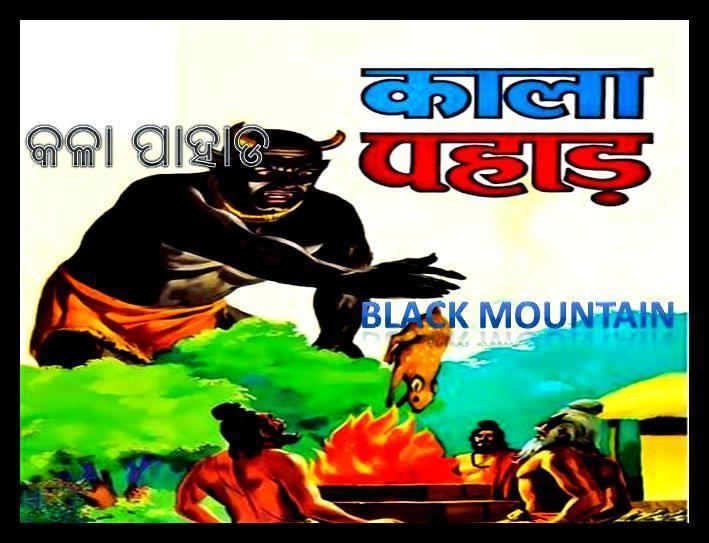Name Kalapahad Kalapahad | ||
 | ||
Bhimkela kalapahad chaitra jatra
Kalapahad or Kala Pahar (Black Mountain) was the title of a Muslim general of Mughal governor Sultan Sulaiman Karrani of Bengal. According to some historical documents he was Rajiv Lochan Ray or Kalachand Roy Bhadury a Bengali (Barendra Brahmin) General of Gour Sultanate, converted to Islam. After conversion to Islam he became Muhammad Farmuli, but is popularly known as Kalapahad. He was instrumental in conquering parts of Odisha for the Afghans of Bengal. Bangladeshi scholar Ghulam Murshid has said that the figure of Kalapahad is largely fictional.
Contents
- Bhimkela kalapahad chaitra jatra
- The Story Of Kalapahada Will Astonish You
- Conversion of Rajiv Lochan Ray
- Konark Sun Temple
- Other campaigns
- Tomb of Kalaphad
- References
କଳାପାହାଡ ର ଏ କାହାଣୀ ଜାଣିଲେ ଆପଣ ଆଶ୍ଚର୍ଯ୍ୟ ହୋଇଯିବେ | The Story Of Kalapahada Will Astonish You |
Conversion of Rajiv Lochan Ray
After the defeat in the Battle of Tribeni, Sulaiman Karrani was forced to make peace. He realized that he would never be able to conquer Bhurishrestha unless he could defeat Rajiv Lochan Ray. Sulaiman Karrani invited Rajiv Lochan Ray for negotiations in his palace. Rajiv Lochan Ray met and fell in love with the daughter of Sulaiman Karrani and willingly converted to Islam. According to other sources, Sulaiman Karrani planned to have Rajiv or Kalachand fall in love with beautiful and charming daughter by including her in meetings and feasts with him. He offered Rajiv Lochan Ray to convert to Islam to which he offered to convert his daughter to Hinduism and marry her. However, contemporary Hindu scholars opposed to such a matrimonial alliance and decreed that conversion to Hinduism was illegal. Enraged, Rajiv Lochan Ray converted and married Karrani's daughter taking the name of Kalapahad (Black Hill - the destroyer). He led Karrani's revenge over Mukundadeva and attacked Odisha. He defeated Mukundadeva and sacked major towns and religious places of Odisha including Hijli, Cuttack, Jajpur, Sambalpur, Konark, Ekamrakhsetra, Puri etc. in 1568. It alleged that he forcefully converted thousands and of Hindus into Muslims and terrorised the undivided Bengal, Bihar and Orissa by Destroying many temples and Hindu deities as revenge.
Konark Sun Temple
The most popular theory about the root of the fall of Konark temple rests with the Kalapahad, the general of Bengal Sultan Sulaiman Khan Karrani. According to some accounts Kalapahad was formerly a Hindu Kayastha officer, however he had converted to Islam. According to Afsanah-i-Shahan of Shaikh Kabir Batini, he was a Batini Afghan. According to the history of Odisha, Kalapahad invaded Odisha in 1568. He destroyed Konark temple, as well as a number of Hindu temples in Odisha. The Madala Panji of Puri Jagannath temple describes how Kalapahad attacked Odisha in 1568. Including Konark temple, he broke most of the images in most of the Hindu temples in Odisha. Though the stone walls are of 20 feet (6.1 m) to 25 feet (7.6 m) thick, he somehow managed to displace the Dadhinauti (Arch stone) and thus caused the tower to collapse. He also damaged most of the images and other side temples of Konark. Due to displacement of the Dadhinauti, the tower gradually collapsed and the roof of the Mukhasala was also damaged, due to the stones falling down from the temple top.
Other campaigns
While Sulaiman was busy in his Orissa campaign, the Koch king Bishwa Singh sent his son Sukladhwaja alias Chila Rai at the head of an army to invade the northwestern regions of Bengal. But Kalapahar opposed the Kuch army, overwhelmed Sukladhwaja and held him prisoner. Afterwards he besieged the capital of Koch Bihar. He once came to conquer and destroy the famous Bargabheema temple of Tamluk, Bengal, but was fascinated by the temple and the idol figure. Instead of destroying it, he wrote a praise for it in his royal seal.
Tomb of Kalaphad
Kalpahad was buried in Sambalpur, Odisha. Large number of tombs believed to be those of the dead soldiers of Kalapahar are located in a mango grove near Samaleswari College building on the bank of river Mahanadi in Odisha. In 2006 a nationalist Hindu group destroyed those tombs.
